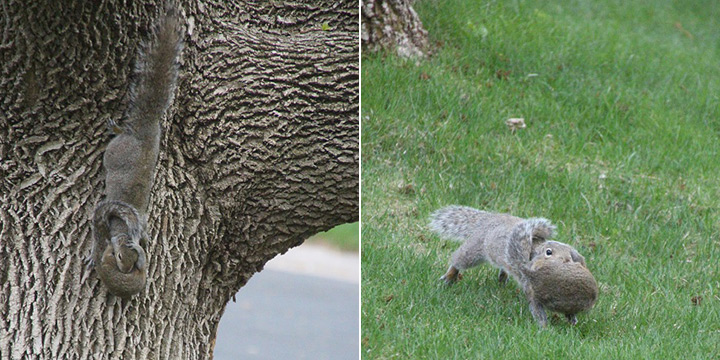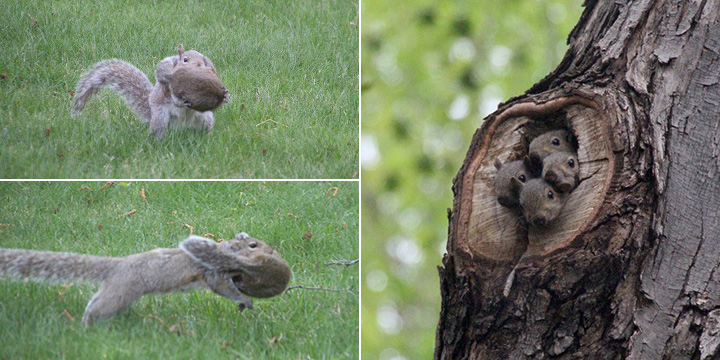NOTE: I have received so many requests for professional help with squirrel relocation, that I have made this complete listing of hundreds of (link ->) professional squirrel removal experts who I trust, serving every city in the USA.
What type of area to relocate to? First of all, laws may prohibit the release on public lands. As for what area is best for the animal, that's a matter of debate. A lot of people think the squirrel should be taken out to "the woods". Many people suggest an undeveloped area with water sources nearby. Still other people argue that animals caught in urban or suburban areas are used to such environments and will fare better in such areas - but they will probably cause the same problems they caused in your area. I think that relocation is hard on animals, no matter where they go. They are used to their home territory.

NEED LOCAL HELP? We are wildlife removal professionals servicing 95% of the USA. Click here to hire our local squirrel removal expert in your home town. Updated 2021. But read the below advice first!
What about baby squirrels? I mention on my home page relocating babies if you have their mother. A rehabber gave me this advice: "As far as releasing babies after the mother bolts, I would not recommend that unless the babies are mobile on their own and even then, if you have two traps of animals, release the babies first, then the mother/babies. The tiny ones are sometimes abandoned if the mother is inexperienced so I would add that people should check the release site daily until they are sure the babies have been retrieved. Encourage people to leave the babies in their yard because the mothers (both squirrel and squirrel) have alternate den sites already in reserve. And then fix their house. Also, when leaving helpless orphans as bait, they need a heat source. Double bagged hot water (zip lock bags) or a jar of hot water that the babies can move toward for warmth will usually work, though monitoring is required to make sure the mother has come back for them which can take more than a day if her alternate is a long distance away. Squirrels take them one at a time but won't touch them if they are cold."
Another rehabber suggested that perhaps a squirrel box could be built on the property, and the animals released there, after the main house and attic are sealed and secure. Here is her whole letter:
The problem that relocating a squirrel is that if they are taken to a area that is already "full" of squirrels, that one will get run off. Then there is the problem with relocating a mom with babies. If she is just let go, she has no place to take her babies to once they are released at the new site. I know most squirrel moms are very good mothers and are by far better than us rehabbers ever could be (even though some of us don't like to admit that.. lol) but I guess you see my dilemma with this.
There are times when the people do relocate them, but they don't stop and think about where they are relocating them to and what type of environment they are releasing them in, especially if they are releasing a mom with babies. It would be like taking them out of their house with their kids and dumping them in a new location with no home.
Like I said, I slept on this and tried to come up with a suggestion, but just couldn't. What I try to suggest to people is to try to make their attic as unlivable from the squirrels perspective as possible, i.e. lights at night, loud music.. etc., but at the same time to build them a nesting box, which I have plans for on the website and place it in a tree in their yard, and hopefully the mom will move her babies to that nestbox. Then they can repair the entrance/exit holes into their attic to keep others from moving in.
Another rehabber that I talked to offered this advice:
I do differ with your assessment of a squirrels ability to move their young. They have rodent teeth and it's very hard if not impossible for a mama squirrel to relocate her young, with the possible exception of when they are newborns. Most certainly, after that size, the squirrels have to stay where they are until they are old enough to move themselves. Also, when I release young squirrels after rehab during cooler weather, I make sure there will be at least a week minimum of acceptable weather before they would need to find shelter. I would think it would take a mom that long or longer to set up a new drey since hers would have to be much thicker and stronger if babies were involved.
About the only safe advice I have (safe for the squirrel and babies, not necessarily humans!) is to bring the whole batch to a licensed wildlife rehabber and see if they can set up an arrangement for the entire litter (including mom) until the babies are old enough to be released with mom. I usually try to have the homeowners locate all of the squirrel entrances right away, but then wait until the babies are old enough to be going in and out by themselves and then use a one way door arrangement to get them out, after which they fix the holes. Read about What should I do with a squirrel after I catch it?
An astute reader of this site has evidence that the above wildlife rehabber is wrong. A woman named Adrianne sent me this email and then sent me the photographs below:
In searching your website, the statement above was written by a rehabber. Although they would be more knowledgeable than us, we had a different experience. A storm was coming, we noticed a mother squirrel running with something pretty large in her mouth, then running back to another yard. I told my neighbor, who is a camera nut and she took a series of photos of the mother carrying each of her young from her tree to our neighbors tree, which had a big hole higher up. After she ran with each one, put them in the tree hole, all four popped their heads out at the same time and my neighbor took a great photo of them. Our city was having a local photo contest and she won a prize with the photo. By the size of the squirrels, they weren't little babies, and a few days later, they were out and running.
She then sent the photos taken by the neighbor. Photo credits to Shirley Zimmerman of the Twin Cities.


The story was that a storm was coming. My neighbor, Shirley Zimmerman, who loves taking photos, saw a squirrel coming out of her tree carrying something and when she realized they were her young ones, she grabbed her camera and started taking pictures. One by one, the mother carried each of the young to a tree two doors down. We never got the storm, but we can only assume it was why she was moving them. We don't know.
Go back to the Squirrels in the Attic home page.
NEED SQUIRREL REMOVAL HELP? We service over 150 USA cities. click gere to hire us in your home town. Updated 2021.